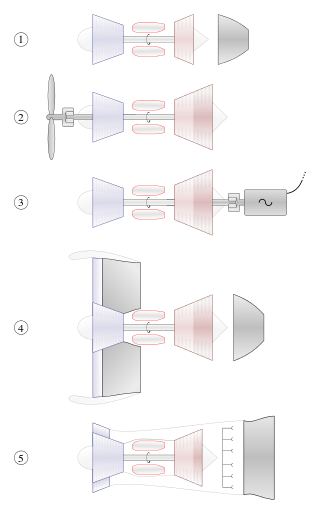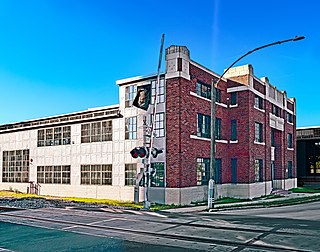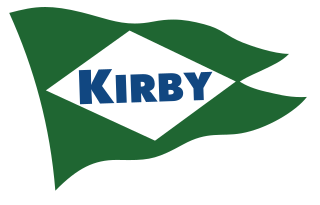
A locomotive or engine is a rail transport vehicle that provides the motive power for a train. If a locomotive is capable of carrying a payload, it is usually rather referred to as a multiple unit, motor coach, railcar or power car; the use of these self-propelled vehicles is increasingly common for passenger trains, but rare for freight.

A gas turbine, also called a combustion turbine, is a type of continuous flow internal combustion engine. The main parts common to all gas turbine engines form the power-producing part and are, in the direction of flow:

An auxiliary power unit (APU) is a device on a vehicle that provides energy for functions other than propulsion. They are commonly found on large aircraft and naval ships as well as some large land vehicles. Aircraft APUs generally produce 115 V AC voltage at 400 Hz, to run the electrical systems of the aircraft; others can produce 28 V DC voltage. APUs can provide power through single or three-phase systems.

A railcar is a self-propelled railway vehicle designed to transport passengers. The term "railcar" is usually used in reference to a train consisting of a single coach, with a driver's cab at one or both ends. Some railway companies, such as the Great Western, termed such vehicles "railmotors".

A stationary engine is an engine whose framework does not move. They are used to drive immobile equipment, such as pumps, generators, mills or factory machinery, or cable cars. The term usually refers to large immobile reciprocating engines, principally stationary steam engines and, to some extent, stationary internal combustion engines. Other large immobile power sources, such as steam turbines, gas turbines, and large electric motors, are categorized separately.

A diesel–electric transmission, or diesel–electric powertrain is a transmission system for vehicles powered by diesel engines in road, rail, and marine transport. Diesel–electric transmission is based on petrol–electric transmission, a very similar transmission system used for petrol engines.
The Detroit Diesel Series 50 is an inline four-cylinder diesel engine, that was introduced in 1993 by Detroit Diesel. The Series 50 was developed from the existing block of its sister engine, the Series 60, which itself was initially designed by Detroit Diesel. The cylinder heads were cast by John Deere at one time.

MTU Friedrichshafen GmbH is a German manufacturer of commercial internal combustion engines founded by Wilhelm Maybach and his son Karl Maybach in 1909. Wilhelm Maybach was the technical director of Daimler-Motoren-Gesellschaft (DMG), a predecessor company of the German multinational automotive corporation Daimler AG, until he left in 1907. On 23 March 1909, he founded the new company, Luftfahrzeug-Motorenbau GmbH, with his son Karl Maybach as director. A few years later the company was renamed to Maybach-Motorenbau GmbH, which originally developed and manufactured diesel and petrol engines for Zeppelins, and then railcars. The Maybach Mb.IVa was used in aircraft and airships of World War I.

Oshkosh Corporation, formerly Oshkosh Truck, is an American industrial company that designs and builds specialty trucks, military vehicles, truck bodies, airport fire apparatus, and access equipment. The corporation also owns Pierce Manufacturing, a fire apparatus manufacturer in Appleton, Wisconsin, and JLG Industries, a leading manufacturer of lift equipment, including aerial lifts, boom lifts, scissor lifts, telehandlers and low-level access lifts.

Allis-Chalmers was a U.S. manufacturer of machinery for various industries. Its business lines included agricultural equipment, construction equipment, power generation and power transmission equipment, and machinery for use in industrial settings such as factories, flour mills, sawmills, textile mills, steel mills, refineries, mines, and ore mills.

Ruston & Hornsby was an industrial equipment manufacturer in Lincoln, England founded in 1918. The company is best known as a manufacturer of narrow and standard gauge diesel locomotives and also of steam shovels. Other products included cars, steam locomotives and a range of internal combustion engines, and later gas turbines. It is now a subsidiary of Siemens.

The Family of Medium Tactical Vehicles (FMTV) is a series of military vehicles that are based on a common chassis and vary by payload and mission requirements. The FMTV is derived from the Austrian Steyr 12M18 truck, but substantially modified to meet United States Army requirements, these including a minimum 50 percent U.S. content.

Yanmar Co., Ltd. is a Japanese diesel engine, heavy machinery and agricultural machinery manufacturer founded in Osaka, Japan in 1912. Yanmar manufactures and sells engines used in a wide range of applications, including seagoing vessels, pleasure boats, construction equipment, agricultural equipment and generator sets. It also manufactures and sells, climate control systems, and aquafarming systems, in addition to providing a range of remote monitoring services.

Marine propulsion is the mechanism or system used to generate thrust to move a watercraft through water. While paddles and sails are still used on some smaller boats, most modern ships are propelled by mechanical systems consisting of an electric motor or internal combustion engine driving a propeller, or less frequently, in pump-jets, an impeller. Marine engineering is the discipline concerned with the engineering design process of marine propulsion systems.
Superior Engines is a brand of industrial combustion engines that has a history which stretches back to 1889 when Patrick J Shouvlin opened a small industrial engineering shop in Springfield, Ohio. In an effort to capitalize on the growing need for oil pumping engines, P. J. Shouvlin developed and sold his first gas engine for oilfield pumping applications. Twenty-five years later, the Superior Gas Engine Company was selling a line of engines which ranged from 20 to 100 horsepower (75 kW).

Advanced steam technology reflects an approach to the technical development of the steam engine intended for a wider variety of applications than has recently been the case. Particular attention has been given to endemic problems that led to the demise of steam power in small- to medium-scale commercial applications: excessive pollution, maintenance costs, labour-intensive operation, low power/weight ratio, and low overall thermal efficiency; where steam power has generally now been superseded by the internal combustion engine or by electrical power drawn from an electrical grid. The only steam installations that are in widespread use are the highly efficient thermal power plants used for generating electricity on a large scale. In contrast, the proposed steam engines may be for stationary, road, rail or marine use.

Cameron International Corporation (formerly Cooper Cameron Corporation (CCC) and Cooper Oil Tool, Cameron Iron Works) though now operating under Schlumberger, is a global provider of pressure control, production, processing, and flow control systems as well as project management and aftermarket services for the oil and gas and process industries. Cameron was acquired by Schlumberger (SLB) in 2016, and now operates as 'Cameron, a Schlumberger Company.' At the start of the SLB acquisition in 2015, Cameron employed approximately 23,000 people and delivered $9.8 billion in revenue.

Perkins Engines Company Limited, a subsidiary of Caterpillar Inc. since 1998, is primarily a diesel engine manufacturer for several markets including agricultural, construction, material handling, power generation, and industrial. It was established in Peterborough, England in 1932. Over the years, Perkins has expanded its engine catalogue, producing thousands of different engine specifications including diesel and petrol engines automatives.

An internal combustion engine is a heat engine in which the combustion of a fuel occurs with an oxidizer in a combustion chamber that is an integral part of the working fluid flow circuit. In an internal combustion engine, the expansion of the high-temperature and high-pressure gases produced by combustion applies direct force to some component of the engine. The force is typically applied to pistons, turbine blades, a rotor, or a nozzle. This force moves the component over a distance, transforming chemical energy into kinetic energy which is used to propel, move or power whatever the engine is attached to.

Kirby Corporation, headquartered in Houston, Texas is the largest tank barge operator in the United States, transporting bulk liquid products throughout the Mississippi River System, on the Gulf Intracoastal Waterway, along all three U.S. Coasts, and in Alaska and Hawaii. Products transported by Kirby include petrochemicals, black oil, refined petroleum products and agricultural chemical products by tank barge. Kirby also owns and operates eight ocean-going barge and tug units transporting dry-bulk commodities in United States coastwise trade.



















